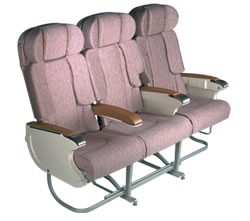Lower Headrests Mean Lower Safety
 The National Air Traffic
Controllers Association is taking the FAA to task over the agency's
"clarification" of a safety regulation affecting front seat rows on
commercial airliners. The regulation, in place since 1998, mandates
headrests on those seats to provide head impact protection for
passengers.
The National Air Traffic
Controllers Association is taking the FAA to task over the agency's
"clarification" of a safety regulation affecting front seat rows on
commercial airliners. The regulation, in place since 1998, mandates
headrests on those seats to provide head impact protection for
passengers.
The FAA's "policy change" to 14 CFR 25.562(c) no longer requires
head impact protection for those front row seat passengers taller
than approximately 5-foot-9. NATCA says this will allow seating
designs that bring the first rows closer to the bulkheads -- adding
room for, yes, more seats -- and potentially resulting in a taller
passenger's head striking the bulkhead wall in the event of an
incident that forces passengers forward in a violent fashion.
"If you are taller than 5-foot-9, you may want to avoid sitting
in the front row of the next generation of commercial aircraft,"
said Tomaso DiPaolo, who represents the FAA's aircraft
certification employees for NATCA. "Instead of standing up to the
industry it is entrusted to regulate, the FAA chose to endorse this
unwarranted reduction in public safety and our employees want to
know this change is occurring without their expertise or
approval.”
"Many of the FAA’s own Aircraft Certification Engineers,
which NATCA represents, opposed this change," DiPaolo adds. "In
fact, on behalf of those engineers, NATCA submitted formal comments
in opposition to this change. The referenced safety regulation
states in part that, 'each occupant must be protected from serious
head injury.' In the FAA's response to NATCA's comments, the agency
conceded that the 'range of occupants' considered when interpreting
the term 'each occupant' has consistently been between the five
percent female on the small side and the 95 percent male on the
large side, but that under the new policy the level of protection
provided to those occupants larger than an average male will simply
not be evaluated.”
 In its response to
NATCA's comments, the FAA quotes the airlines as saying "a few
inches of floor space is very valuable," DiPaolo said.
In its response to
NATCA's comments, the FAA quotes the airlines as saying "a few
inches of floor space is very valuable," DiPaolo said.
"The FAA appears to have adopted a new 'don't ask, don't tell'
policy for taller passengers to simply give the airlines those two
to three inches," DiPaolo said. "For the last 20 years, there have
been clear and consistent engineering principles being applied to
protect a majority of aircraft passengers. Now those principles are
being thrown out the window because the FAA has decided that
assuring such protection 'is a business decision on the part of the
Industry.'"
DiPaolo adds NATCA is concerned passengers in the front rows on
new commercial aircraft won't realize their seats don't adhere to
the same safety standards as before.
"At least in your car you get airbags, a shoulder harness and
padding, why should you expect less impact protection in a modern
commercial airplane? Who is the FAA protecting with this kind of
decision-making? It's certainly not the traveling public," DiPaolo
said.
 ANN FAQ: Submit a News Story!
ANN FAQ: Submit a News Story! Aero-News: Quote of the Day (06.12.24)
Aero-News: Quote of the Day (06.12.24) ANN's Daily Aero-Linx (06.12.24)
ANN's Daily Aero-Linx (06.12.24) ANN's Daily Aero-Term (06.12.24): Adcock Range
ANN's Daily Aero-Term (06.12.24): Adcock Range Airborne Affordable Flyers 06.06.24: 200th ALTO, Rotax SB, Risen 916iSV
Airborne Affordable Flyers 06.06.24: 200th ALTO, Rotax SB, Risen 916iSV




